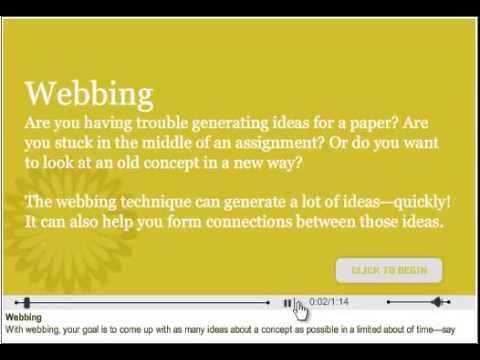15.7: Mapping Your Topic
- Page ID
- 69772
\( \newcommand{\vecs}[1]{\overset { \scriptstyle \rightharpoonup} {\mathbf{#1}} } \)
\( \newcommand{\vecd}[1]{\overset{-\!-\!\rightharpoonup}{\vphantom{a}\smash {#1}}} \)
\( \newcommand{\id}{\mathrm{id}}\) \( \newcommand{\Span}{\mathrm{span}}\)
( \newcommand{\kernel}{\mathrm{null}\,}\) \( \newcommand{\range}{\mathrm{range}\,}\)
\( \newcommand{\RealPart}{\mathrm{Re}}\) \( \newcommand{\ImaginaryPart}{\mathrm{Im}}\)
\( \newcommand{\Argument}{\mathrm{Arg}}\) \( \newcommand{\norm}[1]{\| #1 \|}\)
\( \newcommand{\inner}[2]{\langle #1, #2 \rangle}\)
\( \newcommand{\Span}{\mathrm{span}}\)
\( \newcommand{\id}{\mathrm{id}}\)
\( \newcommand{\Span}{\mathrm{span}}\)
\( \newcommand{\kernel}{\mathrm{null}\,}\)
\( \newcommand{\range}{\mathrm{range}\,}\)
\( \newcommand{\RealPart}{\mathrm{Re}}\)
\( \newcommand{\ImaginaryPart}{\mathrm{Im}}\)
\( \newcommand{\Argument}{\mathrm{Arg}}\)
\( \newcommand{\norm}[1]{\| #1 \|}\)
\( \newcommand{\inner}[2]{\langle #1, #2 \rangle}\)
\( \newcommand{\Span}{\mathrm{span}}\) \( \newcommand{\AA}{\unicode[.8,0]{x212B}}\)
\( \newcommand{\vectorA}[1]{\vec{#1}} % arrow\)
\( \newcommand{\vectorAt}[1]{\vec{\text{#1}}} % arrow\)
\( \newcommand{\vectorB}[1]{\overset { \scriptstyle \rightharpoonup} {\mathbf{#1}} } \)
\( \newcommand{\vectorC}[1]{\textbf{#1}} \)
\( \newcommand{\vectorD}[1]{\overrightarrow{#1}} \)
\( \newcommand{\vectorDt}[1]{\overrightarrow{\text{#1}}} \)
\( \newcommand{\vectE}[1]{\overset{-\!-\!\rightharpoonup}{\vphantom{a}\smash{\mathbf {#1}}}} \)
\( \newcommand{\vecs}[1]{\overset { \scriptstyle \rightharpoonup} {\mathbf{#1}} } \)
\( \newcommand{\vecd}[1]{\overset{-\!-\!\rightharpoonup}{\vphantom{a}\smash {#1}}} \)
Article links:
“Research and the Writing Process” provided by Lumen Learning
“The Writing Process: How Do I Begin?” provided by Lumen Learning
Writing for Success “Steps in Developing a Research Proposal” by University of Minnesota
Chapter Preview
- Describe the process of brainstorming.

Research and the Writing Process
provided by Lumen Learning
Now that you have developed your topic, research question, and thesis, it is time to develop a framework for your entire paper. At this point, you have not started your research in earnest, but your outline will help guide your research and ensure that you find the resources that will help you prove your thesis.
The Writing Process: How Do I Begin?
provided by Lumen Learning
Brainstorming
Brainstorming is similar to list making. You can make a list on your own or in a group with your classmates. Start with a blank sheet of paper (or a blank computer document) and write your general topic across the top. Underneath your topic, make a list of more specific ideas. Think of your general topic as a broad category and the list items as things that fit in that category. Often you will find that one item can lead to the next, creating a flow of ideas that can help you narrow your focus to a more specific paper topic.
The following is Mariah’s brainstorming list:
Writing for Success
by University of Minnesota
Exploring Your Topic in Writing
“How am I supposed to narrow my topic when I haven’t even begun researching yet?” In fact, you may already know more than you realize. Review your list and identify your top two or three topics. Set aside some time to explore each one through freewriting. (For more information about freewriting, see Chapter 8 “The Writing Process: How Do I Begin?”.) Simply taking the time to focus on your topic may yield fresh angles.
Jorge knew that he was especially interested in the topic of diet fads, but he also knew that it was much too broad for his assignment. He used freewriting to explore his thoughts so he could narrow his topic. Read Jorge’s ideas.
Writing at Work
At work, you may need to research a topic quickly to find general information. This information can be useful in understanding trends in a given industry or generating competition. For example, a company may research a competitor’s prices and use the information when pricing their own product. You may find it useful to skim a variety of reliable sources and take notes on your findings.
Tip
The reliability of online sources varies greatly. In this exploratory phase of your research, you do not need to evaluate sources as closely as you will later. However, use common sense as you refine your paper topic. If you read a fascinating blog comment that gives you a new idea for your paper, be sure to check out other, more reliable sources as well to make sure the idea is worth pursuing.
Important Concepts
outline
brainstorming
Licenses and Attributions
CC LICENSED CONTENT, ORIGINAL
Composing Ourselves and Our World, Provided by: the authors. License: Attribution 4.0 International (CC BY 4.0)
CC LICENSED CONTENT INCLUDED
This chapter contains an adaptation from English Composition 2. Authored by: Lumen Learning License: CC BY: Attribution
ENGL002: English Composition II. Provided by: Saylor Academy. Located at: http://www.saylor.org/courses/engl002/. License: CC BY: Attribution
This chapter contains an adaptation from Writing for Success by University of Minnesota is licensed under a Creative Commons Attribution-NonCommercial-ShareAlike 4.0 International License
Research and the Writing Process provided by Lumen Learning
https://courses.lumenlearning.com/englishcomp21xmaster/chapter/activity-mapping-your-topic/
The Writing Process: How Do I Begin? provided by Lumen Learning
https://courses.lumenlearning.com/sac-businesscommunication/chapter/7-1-apply-prewriting-models/
Writing for Success by University of Minnesota
https://open.lib.umn.edu/writingforsuccess/chapter/11-2-steps-in-developing-a-research-proposal/
MULTIMEDIA CONTENT INCLUDED
Video 1 Webbing. Provided by: Saylor Academy. Located at: http://youtu.be/rhuoarTozf8. License: All Rights Reserved. License Terms: Standard YouTube License



